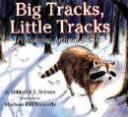Introduction:
Being able to classify and identify objects in the world has become an important apsect of the elementary curriculm. Children are required to be able to differentiate between different animals, especially relating to certain characteristics such as color and look. Big Track, Little Tracks is a good book that describes how certain animals in the real world appear and characteristics that help differentiate them. This book provides an opportunity for the child to be a nature observer and what they will become in contact with during the observation. The author, Millicent. E Selsman and illustrator Marlene Hill Donnelly take children on the route of an observer and help them learn what scientists look for when making observations and classifications.
Summary:
This book takes children through a forest and other natural settings discovering different animals and the footprints that they leave. Throughout the book the children are introduced to a range of animals in sizes and paw prints becoming more inclined to establish the difference between the animals. In the beginning of the book the author provides an explanation of how detectives are able to determine who or what was at a specific site. ” One way is to look for the marks someone or something has made- fingerprints, footprints, the tracks made by bike tires.” They have pictures of animals on one side of the page and on other page they have objects that are related to the certain animal. The book helps distinguish the difference between a cat footprint and dog footprint by providing exact detail of the difference between the two footprints.
Curriculum Connections:
This book could be used in the introduction of Science lesson plan. Before the lesson is given, the teacher could read the book to the class then explain what they are going to do during their lesson. They will be like the the nature observers and practice the skills that they saw in the book. By looking at the book and how nature can be used children will learn that k.1a) basic properties of objects can be identified by direct observation of the objects. They could be given sheets of the same prints that were used in the books matching the animals to their footprints. This sheet will help them establish the skill of k1.c) identifying objects through pictures or verbal. Finally, after reading the book, the teacher could explain to the students that 2.1c) classifying object can be done by using two or more attributes.
Additional Resources:
Try this website which provides a thematic unit on process skills Animal Tracks Science Center Activities
For a lesson plan relating to Categorizing Animals
For a Big Tracks Little Tracks K-W-L sheet try Big Tracks, Little Tracks KWL Chart.
General Information
Book: Big Track, Little Tracks
Author: Millicent E. Selsman
Illustrator: Marlene Hill Donnelly
Publisher: HarperColllins Publishers
Publication Date: 1999
Pages: 32 pages
Grade Range: k-1
ISBN: 9780064451949

